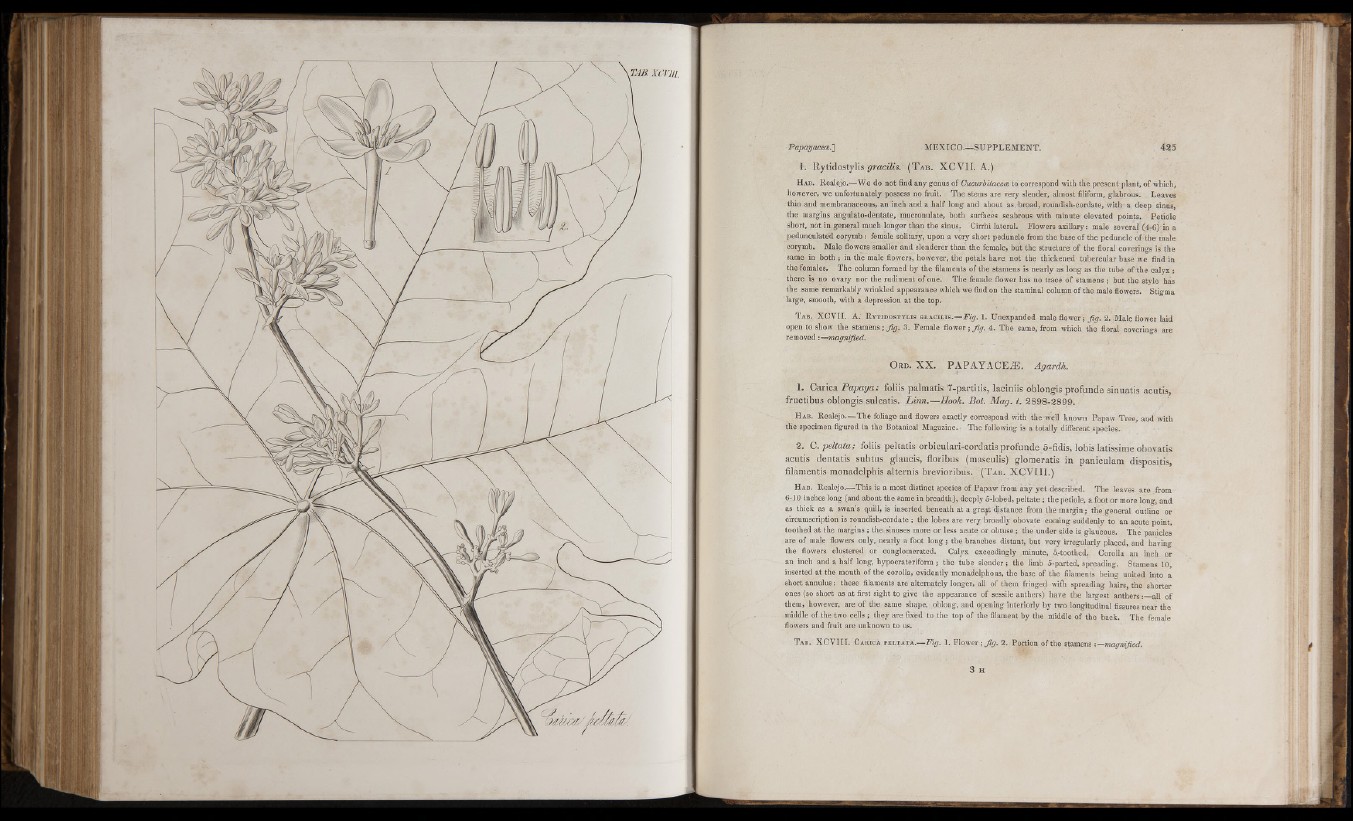
I
1. Rytidostylis i^rctdiis. {T ab. X C V I I . A.)
Hab. Realejo.—We do not find any genus of CucwrbiiacecB to correspond with the present plant, of which,
however, we unfortunately possess no fruit. The stems are very slender, almost filiform, glabrous. Leaves
thin and membranaceous, an inch and a half long and about as. broad, roundish-cordate, with a deep sinus,
the margins angulato-dentate, mucronulate, both surfaces scabrous with minute elevated points. Petiole
short, not in general much longer than the sinus. Cirrhi lateral. Flowers axillary: male several (4-6) in a
pedunculated corymb : female solitary, upon a very short peduncle from the base of the peduncle of the male
corymb. Male flowers smaller and slenderer than the female, but the structure of the floral coverings is the
same in both ; in the male flowers, however, the petals have not the thickened tubercular base we find in
the females. The column formed by the filaments of the stamens is nearly as long as the tube of the calyx ;
there is no ovary nor the rudiment of one. The female flower has no trace of stamens ; but the style has
the same remarkably wrinkled appearance which we find on the staminal column of the male flowers. Stigma
large, smooth, with a depression at the top.
Tab. XCVII. A. Rytidosttlis gracilis.— 1. Unexpanded male flower j fig . 2. Male flower laid
open to show the stamens; fig . 3. Female flower; fig . 4. The same, from which the floral coverings are
removed:—magnified.
O r d . X X . P A P A Y A C E ^ . Agardh.
1. Carica Pap a ya ; foliis palmatis 7-partitis, laciniis oblongis profunde sinuatis acutis,
fructibus oblongis sulcatis. L in n .—Hook. Bot. Mag. t. 2898-2899.
H a b . Realejo.—The foiiage and flowers exactly correspond with the well known Papaw Tree, and with
the specimen figured in the Botanical Magazine. The following is a totally different species.
2. C. peltata; foliis peltatis orbiculari-cordatis p rofunde 5-fidis, Iobis latissime obovatis
acutis dentatis subtus glaucis, floribus (masculis) glomeratis in paniculam dispositis,
filamentis monadelphis alternis brevioribus. ( T a b . X C V I I I.)
H a b . Realejo.— This is a most distinct species of Papaw from any yet described. The leaves are from
6-10 inches long (and about the same in breadth), deeply 5-lobed, peltate ; the petiole, a foot or more long, and
as thick as a swan’s quill, is inserted beneath at a gre^t distance from tbe margin; the general outline or
circumscription is roundish-cordate ; the lobes are very broadly obovate coming suddenly to an acute point,
toothed at the margins ; the sinuses more or less acute or obtuse; the under side is glaucous. The panicles
are of male flowers only, nearly a foot long; the branches distant, but very irregularly placed, and having
the flowers clustered or conglomerated. Calyx exceedingly minute, 5,-toothed. Corolla an inch or
an inch and a half long, hypocrateriform ; the tube slender; the limb 5-parted, spreading. Stamens 10,
inserted at the mouth of the corolla, evidently monadelphous, the base of the filaments being united into a
short annulus: these filaments are alternately longer, all of them fringed with spreading hairs, the shorter
ones (so short as at first sight to give tho appearance of sessile anthers) have the largest anthers:—all of
them, however, are of the same shape, oblong, and opening interiorly by two longitudinal fissures near the
middle of the two cells ; they are fi.ved to the top of the filament by the middle of the back. The female
flowers and fruit are unknown to us.
Tab. XCVIII. Carica peltata.—Ffp-. 1. Flower ; fig . 2. Portion of the stamens -.—magnified.